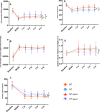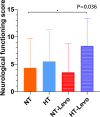Synergistic Effects of Moderate Therapeutic Hypothermia and Levosimendan on Cardiac Function and Survival After Asphyxia-Induced Cardiac Arrest in Rats
- PMID: 32476598
- PMCID: PMC7429058
- DOI: 10.1161/JAHA.120.016139
Synergistic Effects of Moderate Therapeutic Hypothermia and Levosimendan on Cardiac Function and Survival After Asphyxia-Induced Cardiac Arrest in Rats
Abstract
Background This study investigated whether levosimendan, an inotropic calcium sensitizer, when combined with moderate therapeutic hypothermia, may exert synergistic benefits on post-cardiac arrest myocardial dysfunction and improve outcomes. Methods and Results After 9.5-minute asphyxia-induced cardiac arrest and resuscitation, 48 rats were randomized equally into 4 groups following return of spontaneous circulation (ROSC), including normothermia, hypothermia, normothermia-levosimendan, and hypothermia-levosimendan groups. For the normothermia group, the target temperature was 37°C while for the hypothermia group, the target temperature was 32°C, both of which were to be maintained for 4 hours after ROSC. Levosimendan was administered after ROSC with a loading dose of 10 μg/kg and then infused at 0.1 μg/kg per min for 4 hours. In the hypothermia-levosimendan group, left ventricular systolic function and cardiac output increased significantly, whereas the heart rate and systemic vascular resistance decreased significantly compared with the normothermia group. Also, the concentrations of interleukin 1β at 4 hours post-ROSC and the production of NO between 1 hour and 4 hours post-ROSC were reduced significantly in the hypothermia-levosimendan group compared with the normothermia group. The 72-hour post-ROSC survival and neurological recovery were also significantly better in the hypothermia-levosimendan group compared with the normothermia group (survival, 100% versus 50%, χ2 test, P=0.006). Conclusions Compared with normothermia, only combined moderate therapeutic hypothermia and levosimendan treatment could consistently improve post-cardiac arrest myocardial dysfunction and decrease the release of pro-inflammatory molecules, thereby improving survival and neurological outcomes. These findings suggest synergistic benefits between moderate therapeutic hypothermia and levosimendan.
Keywords: brain injury; cardiac arrest; cardiac dysfunction; hypothermia; inflammation; levosimendan; survival.
Figures






Similar articles
-
Cardioprotective effect of therapeutic hypothermia for postresuscitation myocardial dysfunction.Shock. 2009 Aug;32(2):210-6. doi: 10.1097/SHK.0b013e318196ee99. Shock. 2009. PMID: 19060788
-
Combination of intravenous ascorbic acid administration and hypothermia after resuscitation improves myocardial function and survival in a ventricular fibrillation cardiac arrest model in the rat.Acad Emerg Med. 2014 Mar;21(3):257-65. doi: 10.1111/acem.12335. Acad Emerg Med. 2014. PMID: 24628750
-
HSP70-mediated neuroprotection by combined treatment of valproic acid with hypothermia in a rat asphyxial cardiac arrest model.PLoS One. 2021 Jun 17;16(6):e0253328. doi: 10.1371/journal.pone.0253328. eCollection 2021. PLoS One. 2021. PMID: 34138955 Free PMC article.
-
Target Temperature Management Following Pediatric Cardiac Arrest: A Systematic Review and Network Meta-Analysis to Compare the Effectiveness of the Length of Therapeutic Hypothermia.Cureus. 2022 Nov 18;14(11):e31636. doi: 10.7759/cureus.31636. eCollection 2022 Nov. Cureus. 2022. PMID: 36540517 Free PMC article. Review.
-
Hypothermia versus normothermia after out-of-hospital cardiac arrest: A systematic review and meta-analysis of randomized controlled trials.Ann Med Surg (Lond). 2022 Jan 29;74:103327. doi: 10.1016/j.amsu.2022.103327. eCollection 2022 Feb. Ann Med Surg (Lond). 2022. PMID: 35145684 Free PMC article. Review.
Cited by
-
Inhaled Carbon Dioxide Improves Neurological Outcomes by Downregulating Hippocampal Autophagy and Apoptosis in an Asphyxia-Induced Cardiac Arrest and Resuscitation Rat Model.J Am Heart Assoc. 2022 Nov;11(21):e027685. doi: 10.1161/JAHA.122.027685. Epub 2022 Oct 31. J Am Heart Assoc. 2022. PMID: 36314493 Free PMC article.
-
Effect of therapeutic hypothermia against renal injury in a rat model of asphyxial cardiac arrest: Α focus on the survival rate, pathophysiology and antioxidant enzymes.Mol Med Rep. 2022 Jan;25(1):19. doi: 10.3892/mmr.2021.12535. Epub 2021 Nov 19. Mol Med Rep. 2022. PMID: 34796906 Free PMC article.
-
Optimal inhaled oxygen and carbon dioxide concentrations for post-cardiac arrest cerebral reoxygenation and neurological recovery.iScience. 2023 Nov 16;26(12):108476. doi: 10.1016/j.isci.2023.108476. eCollection 2023 Dec 15. iScience. 2023. PMID: 38187189 Free PMC article.
-
Omecamtiv mecarbil treatment improves post-resuscitation cardiac function and neurological outcome in a rat model.PLoS One. 2022 Feb 17;17(2):e0264165. doi: 10.1371/journal.pone.0264165. eCollection 2022. PLoS One. 2022. PMID: 35176110 Free PMC article.
-
Levosimendan increases brain tissue oxygen levels after cardiopulmonary resuscitation independent of cardiac function and cerebral perfusion.Sci Rep. 2021 Jul 9;11(1):14220. doi: 10.1038/s41598-021-93621-x. Sci Rep. 2021. PMID: 34244561 Free PMC article.
References
-
- Berdowski J, Berg RA, Tijssen JG, Koster RW. Global incidences of out‐of‐hospital cardiac arrest and survival rates: systematic review of 67 prospective studies. Resuscitation. 2010;81:1479–1487. - PubMed
-
- Lemiale V, Dumas F, Mongardon N, Giovanetti O, Charpentier J, Chiche JD, Carli P, Mira JP, Nolan J, Cariou A. Intensive care unit mortality after cardiac arrest: the relative contribution of shock and brain injury in a large cohort. Intensive Care Med. 2013;39:1972–1980. - PubMed
-
- Nolan JP, Neumar RW, Adrie C, Aibiki M, Berg RA, Böttiger BW, Callaway C, Clark RS, Geocadin RG, Jauch EC, et al. Post‐cardiac arrest syndrome: epidemiology, pathophysiology, treatment, and prognostication. A Scientific Statement from the International Liaison Committee on Resuscitation; the American Heart Association Emergency Cardiovascular Care Committee; the Council on Cardiovascular Surgery and Anesthesia; the Council on Cardiopulmonary, Perioperative, and Critical Care; the Council on Clinical Cardiology; the Council on Stroke. Resuscitation. 2008;79:350–379. - PubMed
-
- Huang L, Weil MH, Tang W, Sun S, Wang J. Comparison between dobutamine and levosimendan for management of postresuscitation myocardial dysfunction. Crit Care Med. 2005;33:487–491. - PubMed
-
- Ibáñez B, Heusch G, Ovize M, Van de Werf F. Evolving therapies for myocardial ischemia/reperfusion injury. J Am Coll Cardiol. 2015;65:1454–1471. - PubMed
Publication types
MeSH terms
Substances
LinkOut - more resources
Full Text Sources
Medical

